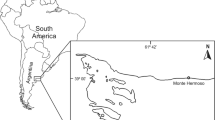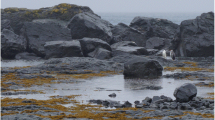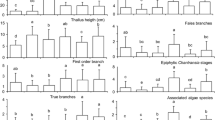Abstract
The foraging behaviour variability of three striped red mullet (Mullus surmuletus L. 1758) populations with respect to the vegetation cover was examined along the French Mediterranean coasts. We tested both the carrying capacity of different habitats and the hypothesis of a food segregation by the invasive alga Caulerpa taxifolia (Vahl) C. Agardh, on the functioning of benthic fish populations. The results indicated a significant site effect on M. surmuletus foraging behaviour and movements. The vegetation cover may play an important role in modifying the striped red mullet cost of foraging (sampling effort) and thus its strategy of prey capture. As long as the cover of marine phanerogams and/or macrophyte algae (Caulerpaceae) increases, the foraging budget and the distances covered in search of prey decrease significantly. Similarly, the striped red mullet increases the prospected sample periods to augment its foraging success, swimming above the bottom. These changes are related to the development of a dense superficial network of plagiotropic rhizomes and stolons, and to the reduction of space between fronds that limits the accessibility to resources and may increase intra-specific food competition. The role of C. taxifolia does not differ from that of other marine phanerogams but induces significant changes in the structure of Mullidae populations at the local level. The rapid expansion of Caulerpaceae in the Mediterranean Sea could constitute a real threat for the balance of the marine coastal biodiversity and the ecology of M. surmuletus, which is considered a flagship species for coastal Mediterranean demersal fisheries.
Similar content being viewed by others

References
Aguirre H. and Lombarte A. 1999. Ecomorphological comparison of sagittae in Mullus barbatus and Mullus surmuletus. Journal of Fish Biology 55: 105–114.
Arculeo M. and Pipitone C. 1989. Aspetti del regime alimentare di Mullus surmuletus L. (Pisces, Mullidae) nel Golfo di Palermo. Oebalia 15: 67–77.
Bellan-Santini D., Arnaud P.M., Belllan G. and Verlaque M. 1996. The influence of the introduced tropical alga Caulerpa taxifolia, on the biodiversity of the Mediterranean marine biota. Journal of the Marine Biological Association of the United Kingdom 76: 235–237.
Boudouresque C.F. and Verlaque M. 2002. Biological pollution in the Mediterranean Sea: invasive versus introduced macrophytes. Marine Pollution Bulletin 44: 32–38.
Boudouresque C.F., Meinesz A., Ribera M.A. and Ballesteros E. 1995. Spread of the green alga Caulerpa taxifolia (Caulerpales, Chlorophyta) in the Mediterranean: consequences of a major ecological event. Scienca Marina 59: 21–29.
Boudouresque C.F., Lemée R., Mari X. and Meinesz A. 1996. The invasive alga Caulerpa taxifolia is not a suitable diet for the sea urchin Paracentrotus lividus. Aquatic Botany 53: 245–250.
Ceccherelli G. and Cinelli F. 1998. Habitat effect on spatio-temporal variability in size and density of the introduced alga Caulerpa taxifolia. Marine Ecology Progress Series 163: 289–294.
Coppola S.R. 2001. Inventory of artisanal fishery communities in the western-central Mediterranean. FAO-COPEMED Project, FAO-FIRM, Rome, Italy, pp. 1–64.
Crowder L.B. and Cooper W.E. 1982. Habitat structural complexity and the interaction between Blue-gills and their prey. Ecology 63: 1802–1813.
Darnaude A.M., Harmelin-Vivien M.L. and Salen-Picard C. 2001. Food partitioning among flatfish (Pisces: Pleuronectiformes) juveniles in a Mediterranean coastal shallow sandy area. Journal of the Marine Biological Association of the United Kingdom 81: 119–127.
Devries D.R., Stein R.A. and Chesson P.L. 1989. Sunfish foraging among patches: the patch-departure decision. Animal Behaviour 37: 455–464.
Dionne M. and Folt C.L. 1991. An experimental analysis of macrophyte growth forms as fish foraging habitat. Canadian Journal of Fisheries and Aquatic Sciences 48: 123–131.
Francour P., Harmelin-Vivien M., Harmelin J.G. and Duclerc J. 1995. Impact of Caulerpa taxifolia colonization on the littoral ichthyofauna of north-western Mediterranean sea: preliminary results. Hydrobiologia 300: 345–353.
Francour P., Ganteaume A. and Poulain M. 1999. Effects of boat anchoring in Posidonia oceanica seagrass beds in the Port-Cros national park (north western Mediterranean sea). Aquatic Conservation: Marine and Freshwater Ecosystems 9: 391–400.
Francour P., Harmelin J.G., Pollard D. and Sartoretto S. 2001. A review of marine protected areas in the northwestern Mediterranean region: sitting, usage, zonation and management. Aquatic Conservation: Marine Freshwater Ecosystems 11: 155–188.
Gili J.M. 2000. Frontline view of an invasion. Science 287: 1762.
Golani D. and Galil B. 1991. Trophic relationships of colonizing and indigenous goatfish (Mullidae) in the eastern Mediterranean with special emphasis on decapod crustaceans. Hydrobiologia 218: 27–33.
Gotceitas V. 1990. Variation in plant stem density and its effects on foraging success of juvenile bluegill sunfish. Environmental Biology of Fishes 27: 63–70.
Grossman G.D. 1980. Ecological aspects of ontogenetic shifts in prey size utilization in the Bay goby (Pisces: Gobiidae). Oecologia 47: 233–238.
Harmelin-Vivien M. 2000. Influence of fishing on the trophic structure of fish assemblages in the Mediterranean seagrass beds. In: CIESM Publ. (ed) Fishing Down the Mediterranean Food Webs? Kerkya, 26–30 July 2000, CIESM Workshop Series 12, Monaco, pp. 39–41.
Harmelin-Vivien M., Francour P. and Harmelin J.G. 1999. Impact of Caulerpa taxifolia on Mediterranean fish assemblages: a six year study. In: UNEP (ed) Proceedings of the Workshop on Invasive Caulerpa species in the Mediterranean, Heraklion, Crete, Greece, 18–20 March 1998, MTS 125, UNEP, Athens, Greece, pp. 127–138.
Harmelin-Vivien M., Francour P., Harmelin J.G. and Le Direac’h. 2001. Dynamics of fish assemblage alterations caused by the introduced Caulerpa taxifolia near Menton (France). In: GIS Posidonie Publ. (ed) Proceedings of the Fourth International Workshop on Caulerpa taxifolia, Lerichi, Italy, 1–2 February 2001, pp. 236–245.
Harrel S.L. and Dibble E.D. 2001. Foraging efficiency of juvenile bluegill, Lepomis macrochirus, among different vegetated habitats. Environmental Biology of Fishes 62: 441–453.
Jousson O., Pawlowski J., Zanetti L., Echman F.W., Dini F., Di Guiseppe G. et al. 2000. Invasive alga reaches California. Nature 408: 157–158.
Kaiser M.J., Collie J.S., Hall S.J., Jennings S. and Poiner I.R. 2002. Modification of marine habitats by trawling activities: prognosis and solutions. Fish and Fisheries 3: 114–136.
Karakassis I. and Eleftheriou A. 1997. The continental shelf of Crete: structure of macrobenthic communities. Marine Ecology Progress Series 160: 185–196.
Komatsu T., Meinesz A. and Buckles D. 1997. Temperature and light responses of alga Caulerpa taxifolia introduced into the Mediterranean Sea. Marine Ecology Progress Series 146: 145–153.
Labropoulou M.A., Machias N., Tsimenides A. and Eleftheriou A. 1997. Feeding habits and ontogenetic diet shift of the striped red mullet, Mullus surmuletus Linneaus, 1758. Fisheries Research 31: 257–267.
Langar H., Djellouli A., Ben Mustapha K. and El Abed A. 2000. Première signalisation de Caulerpa taxifolia en Tunisie. Bulletin de l’Institut National des Sciences et Techniques de la Mer 27: 1–8.
Manuris Z., Apostolidis A.P., Panagiotaki P., Theodorou A.J. and Trantaphyllidis C. 1998. Morphological variation between red mullet populations in Greece. Journal of Fish Biology 52: 107–117.
Meinesz A. and Hesse B. 1991. Introduction et invasion de l’algue tropicale Caulerpa taxifolia en Méditerranée nord-occidentale. Oceanologica Acta 14: 415–426.
Meinesz A., Benichou L., Blachier J., Komatsu T., Lemee R., Molenaar H. et al. 1995. Variations in the structure, morphology and biomass of Caulerpa taxifolia in the Mediterranean sea. Botanica Marina 38: 499–508.
N’Da K. and Deniel C. 1993. Sexual cycle and seasonal changes in the ovary of the red mullet Mullus surmuletus, from the southern coast of Brittany. Journal of Fish Biology 43: 229–244.
Pinnegar J.K., Polunin N.V.C., Francour P., Badalamenti F., Chemello R., Harmelin-Vivien M.L. et al. 2000. Trophic cascades in benthic marine ecosystems: lessons for fisheries and protected-area management. Environmental Conservation 27: 179–200.
Reñones O., Massuti E. and Morales-Nin B. 1995. Life history of the red mullet Mullus surmuletus from the bottom-trawl fishery off the Island of Majorca (north-west Mediterranean). Marine Biology 123: 411–419.
Schoener T.W. 1971. Theory of feeding strategies. Annual Review of Ecology and Systematics 2: 369–404.
Suquet M. and Person-Le Ruyet J. 2001. Les rougets barbets (Mullus barbatus, Mullus surmuletus). Biologie, pêche, marchè et potentiel aquacole. In: IFREMER (ed) France, pp. 1–47.
Vassilopoulou V., Papaconstantinou C. and Christides G. 2001. Food segregation of sympatric Mullus barbatus and Mullus surmuletus in the Aegean Sea. Israel Journal of Zoology 47: 201–211.
Verlaque M. and Fritayre P. 1994. Modifications des communautés algales méditerranéennes en présence de l’algue envahissante Caulerpa taxifolia (Vahl) C. Agardh. Oceanologica Acta 17: 659–672.
Zar J.H. 1999. Biostatistical Analysis. 4th edn. Prentice-Hall, Upper Saddle River, New Jersey, 663 pp.
Author information
Authors and Affiliations
Corresponding author
Rights and permissions
About this article
Cite this article
Longepierre, S., Robert, A., Levi, F. et al. How an invasive alga species (Caulerpa taxifolia) induces changes in foraging strategies of the benthivorous fish Mullus surmuletus in coastal Mediterranean ecosystems. Biodivers Conserv 14, 365–376 (2005). https://doi.org/10.1007/s10531-004-5356-7
Issue Date:
DOI: https://doi.org/10.1007/s10531-004-5356-7



